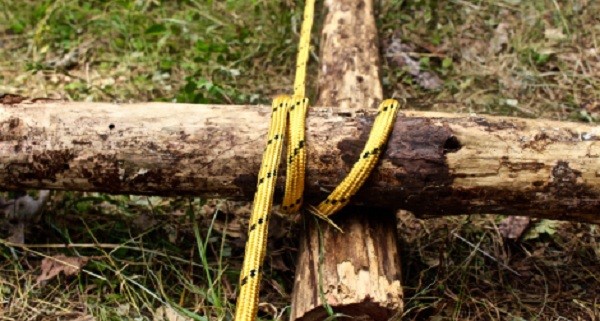Humans move heavy loads with heavy machinery all the time in our modern world. That's not likely to change when the grid goes down. Check out the amazing Flip Flop Winch below to keep on cranking when the power goes out for good.
Flip Flop Winch
In an emergency vehicle kit, weight and space are not an issue – unless you tool around in a Smart Car. For this winch, all you need are two logs and some rope. Of course, you’re not hauling eight foot logs in your vehicle. You will have to cut those with your truck ax or takedown bucksaw.
Material and Tools
Ax or Saw – cut two logs about 8 feet in length
Rope – non-elastic is preferable for safety reasons
Cordage – enough to make two loops about 1 foot in diameter
Cut Two Poles
You’ve hit a ditch or snow bank and need to get unstuck. Reach into your vehicle emergency kit and fetch your saw or ax. You have an emergency vehicle kit, right? Be sure to add 100 feet of strong rope to the kit if you haven’t already. A tow strap won’t be useful with this winch unless it’s really long.
Scout for a straight tree (dead or live – it’s an emergency) to cut. Anything between 4 to 6 inches in diameter is suitable. Cut two lengths in the 8 foot range. De-limb the poles by chopping any branches off with your sharp truck ax.
Lever and Pulley Pole
Now that you’ve got two poles, one will be used as the “lever pole” and the other will be your “pulley pole.”
A larger diameter pulley will winch more rope with each revolution.
Locate an Anchor
The base of a live tree is perfect. Wrap the rope around the base of the anchor twice and tie it off with a tensioning knot.
Ideally, you want the anchor point and the object you’re pulling to form a straight line sighted down the rope.
Both truck and anchor point are lined up for optimal pull.
2 Rigging the Systems
Midway between the anchor and object lay the two poles perpendicular to one another. Run the rope on top of the pulley pole about a foot from the larger end of the pole. Pull the rope back under the pole to form a loop. Insert the lever pole into the loop from the side of the pulley pole where the loop is formed. Give yourself about a foot of lever sticking through the loop.
With the winch rigged, pull the slack out of the line and tie to the object you’re pulling. Another tension knot will work.
Start the Flip-Flop
Flip the lever pole up and over the pulley pole. Once on the ground, check the first wrap on the pulley pole. This is the time to straighten the loops around the pulley before real tension begins. Try to keep the rope from spooling on top of the previous coils as this may weaken the rope. With each flip-flop, the rope will begin coiling on the pulley pole.
Safety Concerns
There are inherent dangers when tension is applied to a rope or cable. If the rope has elasticity and snaps, the potential energy turns to kinetic energy moving like a slingshot or bow and arrow in opposite directions. Use rope without elasticity, nicks, abrasions, and a working load suitable for the task.If you’re alone, you must cross over the rope in this process. Minimize the risk from flying rope by laying a heavy coat or blanket (if available) on the rope at both ends. With two people, nobody has to step over the taut line.
Another safety precaution is to wear leather gloves and eye protection. A smart thing to have handy is a knife handy to cut the rope if you somehow manage to get a hand pinched between the rope and pulley. Not sure how that might happen but better safe than sorry.
This powerful simple machine takes practice to perform properly. With a minimum of tools and some rope, the flip-flop winch can be a life saver on the homestead or in the backcountry. Add it to your preparedness toolbox. Give it a try and share your results.
As the article points out, one of the most useful purposes for this winch is to get your vehicle out of the mud or snow. Keeping an adequate road kit with rope and a saw or axe is going to make that task much easier. Apart from that, the uses for this winch are potentially limitless if you have the resourcefulness to tweak your design. With it, you could move entire trees downed by storms or add security modifications to your house when SHTF, it's really all down to your imagination.
For more helpful tips on how to make this winch work, check out the original article at Survival Sherpa.
Featured Image via Survival Sherpa

Visual http://youtu.be/PYQPi4Gj9z0
This is an awesome machine, especially for a lone person without much resource.
I love this site
Justin Anderson
Not easy with one person